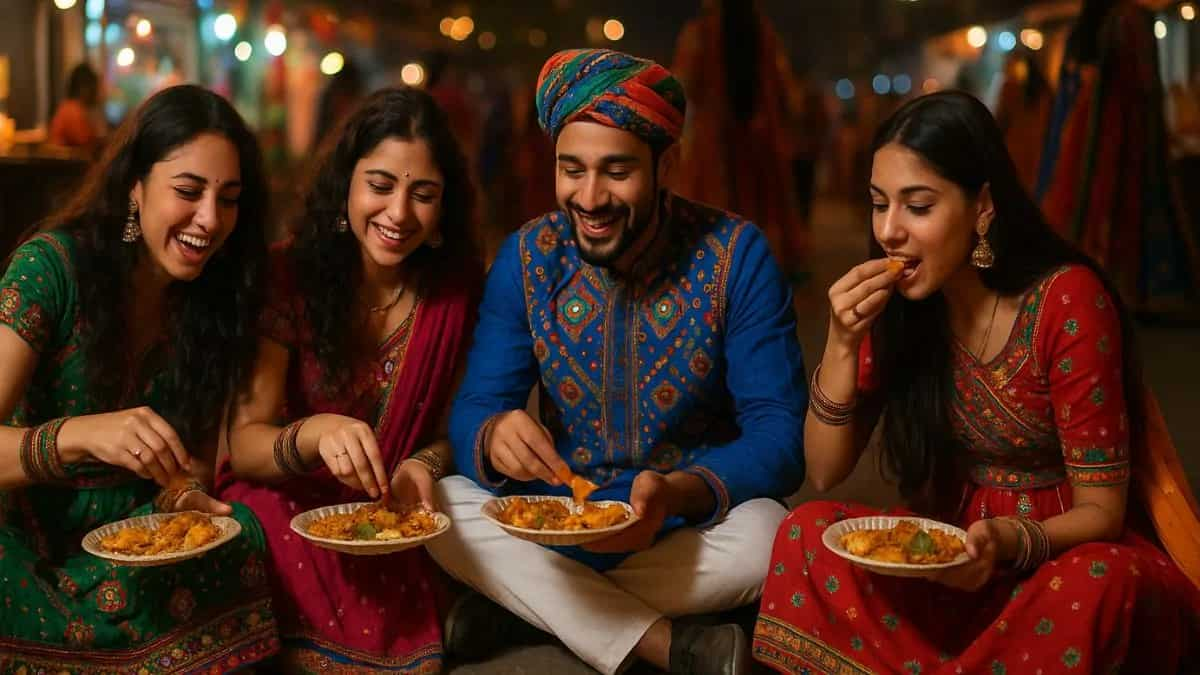
Navratri in Baroda is known for its fervent energy: music, colour, dance and devotion in equal measure. As the dhols quieten only after midnight, another festival of flavours takes over the city’s roads and bylanes. Garba revellers, flushed with exertion and excitement, make their way to cafés, lounges and food stalls, hunting for sustenance and novelty long after conventional dining hours close. Over nine nights, some kitchens stay open till 3 or even 4 a.m., while street food vendors stretch till 5 a.m. The result is a nocturnal foodscape woven tightly into the rhythm of Navratri. This late-night dining has become an inseparable part of the festival, reflecting both the city’s hospitality and its appetite for innovation.
Restaurants And Cafés With Midnight Menus
Several well-known restaurants in Baroda are central to the late-night food movement during Navratri. The Brewery has introduced fusion dishes like thepla tacos and avocado papdi chaat, designed to capture the festive mood of post-Garba diners. One of their chefs explained, “We expect the peak rush after 1 a.m., so we prepare batches of chaat ingredients and lighter plates in advance. People want something fun and flavourful after dancing for hours, not heavy meals.”
The House of Makeba is also known for staying open into the early hours of the morning during the festival. Its team prepares satvik options such as sabudana tikkis and fruit-based chaats, ensuring that those observing fasting traditions are not left out of the celebrations. A manager said, “We keep a smaller but focused menu at night. Guests want something quick, and the demand is constant until almost 3 a.m.”
At 1331 Al Fresco, Navratri has brought curated menus featuring contemporary chaat bowls and fresh beverages. Their staff noted that they extend service until late night to accommodate the post-Garba crowds. “We see people arriving in large groups, often directly from dance venues, and they want light food to share. That’s what shapes our menu choices at night.”
Lollorosso and the Alembic food court have also become late-night hubs, with extended service that caters to the heavy traffic around popular Garba grounds.
Street Food Vendors As The Festival’s Backbone
The street food stalls remain the most accessible option for those heading home after Garba. Vendors along Old Padra Road, Alkapuri and Gotri are known to operate until four or even five in the morning. Chaat sellers prepare papdi, chutneys and toppings in bulk, while pav bhaji stalls maintain constant batches on large tawas to handle the sudden influx. One vendor explained, “We double our stock after midnight. People come in hundreds, and if we do not prepare in advance, the queues become unmanageable. We expect peak between 2 and 3 a.m. so we keep extra mixes ready, premix of papdi, boiled potato cubes, and chutneys in insulated containers.”
He said that during Navratri his earnings roughly triple, and that he stays open till 4:30 or 5 a.m. depending on footfall. Many of these stalls roam near prominent Garba grounds, precisely timed to open just as the dance wraps up. These stalls are often the final stop for many groups before heading home at dawn.
The Logistics Of Running Midnight Kitchens
Operating until such late hours requires planning and resources. Restaurants rotate staff in shifts, hold buffer stocks of perishable items and keep quick-serve options ready. One café owner explained, “We reduce the menu after midnight but keep the fast-moving items. It helps control wastage and still keeps the crowd happy.”
Street vendors face their own logistical challenges. Since suppliers do not operate at those hours, they buy raw materials in larger quantities earlier in the day and rely on insulated containers or portable gas stoves to keep food fresh. For them, the late hours are essential to maximise the limited festival window of opportunity.
A Culture Of Café Hopping And Stall Tours
As soon as Garba winds down, large groups spill onto the streets, often moving from one café to another before heading toward food stalls. Café hopping and stall tours have become part of the Navratri tradition in Baroda, extending socialising well past midnight. Groups often begin with light appetisers at a café, move on to street-side chaat, and end with sweets or tea closer to sunrise.
A frequent attendee described the pattern: “Garba is only one part of the night. After dancing, people want to eat, talk and stretch the evening. That is why cafés and stalls are crowded until morning.” This cycle has created a unique identity for Navratri in Baroda, where food has become as much a feature of the festival as dance.
Sustaining The Festive Appetite
The nine nights of Navratri demand stamina not only from dancers but also from the food industry that supports them. Restaurants and street food vendors must balance heavy footfall, long hours and quick service without compromising on quality. While the effort is immense, the rewards are equally significant. Many vendors report that their earnings during these nine nights sustain them for months. Restaurants also gain new regulars from those who first discover them during Navratri.
The late-night kitchens of Baroda have grown into a parallel celebration, an unbroken chain of flavours and energy that sustains the city’s festive spirit until the morning. In these spaces, food is not simply a necessity after Garba but a continuation of the communal joy that defines Navratri itself.